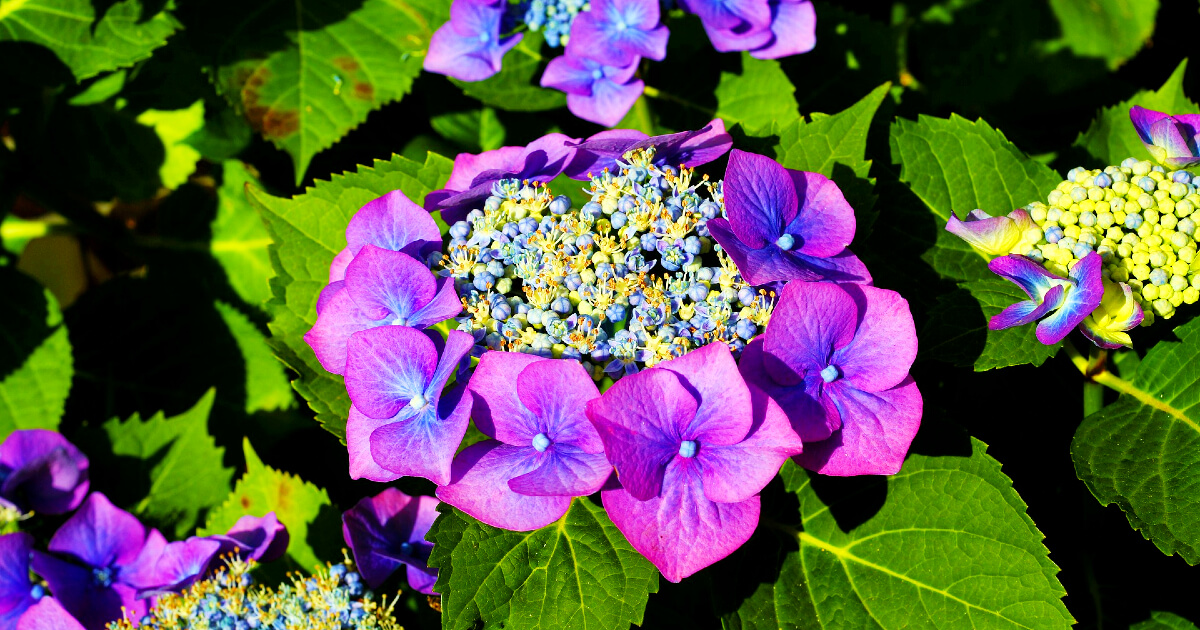Hydrangea is a species of hydrangea in the family Hydrangeaceae and is native to Japan.
The Hydrangea that grows naturally in Japan is called “Gaku Hydrangea(額紫陽花/Gaku-ajisai)” and is also called “Hama Hydrangea(浜紫陽花/Hama-ajisai)” because it grows along the coast.
The most commonly planted spherical hydrangea today is the Seiyo Hydrangea(西洋紫陽花/seiyou-ajisai), a modified version of the Gakushi Hydrangea(額紫陽花/Gaku-ajisai), which originated in Japan.
What is Hydrangea(紫陽花/Ajisai)?

Despite the fact that hydrangeas are an ancient Japanese plant, there are only two poems about hydrangeas in the Manyoshu(万葉集/Collection of Ten Thousand Leaves).
The fact that there are 140 and 120 poems for the popular Hagi (萩/bush clovers) and Ume (梅/plum blossoms), respectively, and 40 poems for cherry blossoms(桜/sakura), shows that hydrangeas were not so popular in the past.
It is said that hydrangeas rarely appear in classical Japanese literature until the Edo period(1603-1867), when Matsuo Basho(松尾芭蕉/Haikai master of the early Edo period) wrote a poem about them.
One theory as to why the hydrangea was not popular is that it was thought to be “fickle” or “immoral” because the colour of the flowers changed after flowering.
It was only after the war that hydrangeas became popular as ornamental plants.
It may be that before the breeding of hydrangeas, they didn’t look like “beautiful flowers” and didn’t attract much attention.
The name “Hydrangea(紫陽花/Ajisai)” is said to be a corruption of the word “Adusai(集真藍)”, meaning “a collection of indigo(藍) colours”.
The Chinese character(漢字/kanji) for “hydrangea(紫陽花)” was given by the Tang Dynasty poet Bai Yi(白居易) to another flower (some say lilac).
However, the poet and scholar of the Heian period (794-1185), Minamoto no Shita-gou(源 順), mistakenly thought the flower was the same as the Japanese hydrangea, and applied this Chinese character(漢字/kanji) to it.
This is why in Japan hydrangeas are still known as “Hydrangeas(紫陽花/Ajisai)” to this day.
The scientific name of the hydrangea, Hydrangea, is derived from the Greek words “hydro” and “angeion”.
Hydrangea’s scientific name means “vessel of water”, which is perfect for a hydrangea that blooms with dignity in the rainy season.
Hydrangea is a deciduous shrub.
The tree is 1-2m tall and has clearly veined, glossy leaves.
The part of the hydrangea that looks like a flower is not a petal, but a deformed leaf called a calyx.
The sepals, also known as ‘ornamental flowers’, are coloured and outwardly look like flower petals.
The sepals do not produce seeds, but the five petals hidden in the centre and the ten stamens are attached to each other to produce seeds.
The pink and blue flowers bloom from May to July and are said to be synonymous with the rainy season, as they look beautiful and dignified even in the rain.
The language of hydrangeas in general is “heartlessness”, “boastfulness”, “You are cold”, “maiden’s love”, “Patient love”, “affair”, “fickle”.
As you can see, it has a positive and a negative language.
Negative words such as “fickle” and “affair” are derived from the fact that the colour of the flowers changes according to the composition of the soil.
The positive language of flowers seems to be of Japanese origin!
In addition, each colour has its own flower language.
Hydrangeas change colour in a variety of ways depending on the nature of the soil and the number of days since flowering.
The colour of the flowers is due to pigments called anthocyanins.
The colour of the flowers depends on the pH (acidity) of the soil: blue if the soil is acidic and red if it is alkaline.
In Japan, where the soil is more acidic, the flowers tend to be blue or bluish-purple in colour.
The colour changes gradually over time, from a pale yellow-green due to the chlorophyll in the flowers, to red and blue due to the decomposition and biosynthesis of anthocyanins and auxiliary pigments.
Over time, organic acids accumulate and the blue flowers turn red.
For this reason, another name for the hydrangea in the seasonal language is “seven changes(七変化/shiti-henge)”.
The changing colours are also reflected in the language of flowers, such as “affair” and “fickle”.
The flowers appear to be clustered together, which gives them a warm and welcoming language, such as “family friendly” and “harmonious”. In terms of colour, pink means “cheerful woman”, blue means “patient love” and white means “tolerance”. The versatility of the hydrangea has led to a wide range of words being used to describe the flower.
The positive language of the flower, on the other hand, seems to have originated from an episode that occurred in the Edo period.
Siebold (1796-1866), a German doctor who came to Japan during the Edo period, had a daughter with a beautiful woman called Otaki, but was eventually expelled from Japan.
When he returned to Germany, he brought back hydrangeas and introduced them under the name ‘Otakusa’, after Otaki-san, which gave rise to the words “maiden’s love” and “patient love”.
The way the flowers bloom close together also gives the impression of a positive floral language in Japan.
Siebold, a German physician, loved hydrangeas and introduced them in his book “Flora of Japan”.
After arriving in Europe, the hydrangea became popular as the “rose of the East” and breeding was carried out in many places.
Eventually, the hydrangea was imported back to Japan as the Western hydrangea.
What a wonderful story!
He was kicked out of Japan and came back to Japan as a western hydrangea… romantic ♥!
About Hydrangea Pattern (紫陽花/Ajisai-mon)
この投稿をInstagramで見る
この投稿をInstagramで見る
Photo From:instagram@echizenyaheita
The hydrangea pattern(紫陽花/Ajisai-mon) is found in the gold brocade patterns(金襴手文様/Kinrande-monyou) of Kiyomizu-yaki and Kutani-yaki ware of the Edo period(1603-1867), and was used in the work of late Edo period(1603-1867) potters such as Ninna midouhati(仁阿弥道八).
Design using Hydrangea Pattern (紫陽花/Ajisai-mon)
この投稿をInstagramで見る
Photo From:instagram@bonbonkeitan
この投稿をInstagramで見る
Photo From:instagram@bonbonkeitan





コメント